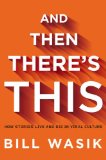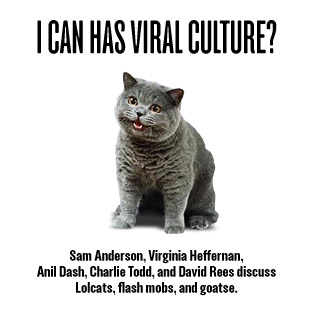And Then There's Us
Starting last week, New York Magazine asked me to participate in a roundtable conversation with NYMag’s book critic Sam Anderson, Improv Everywhere‘s Charlie Todd, the New York Times‘ Virginia Heffernan and David Rees, creator of Get Your War On. In the august company of these Actual Experts, we kicked around a conversation about memes and viral culture, inspired by Bill Wasik’s And Then There’s This, his newly-released book whose requisite explanatory subtitle is “How Stories Live and Die in a Viral Culture”. We didn’t talk too much about the “death” part, but the rest of it we got into in depth and it ended up being a blast to participate in the conversation.
Sam started us off with a strong intro, but I really lit up when Virginia cut to the heart of one of my biggest linguistic peeves with this entire topic of conversation: the word “viral”. In her own words:
I see why virology is metaphorically convenient, but as a YouTube obsessive I’ve also been curious about a particular inadequacy in the analogical system. My problem with the analogy might seem trivial, but I think it bears on our understanding of Wasik’s justly celebrated Flash Mobs. …
I understand how the chain-letter thing is vaguely viral: One person who is “infected” with certain information touches you, via e-mail, with that information and then you’re infected. But I don’t get how accepting a widely disseminated invitation to go somewhere—to a website, to YouTube, to Toys “R” Us—is like getting a virus. Viruses seem so yours, don’t they, when you have them, and you’re very much the host, even if your physiological party’s been crashed. By contrast, getting invited somewhere, willingly accepting the invitation, and joining a gathering makes you a guest and makes the whole experience, to my mind, not very viruslike.
From there, the conversation took off (perhaps thanks to the promotional graphic on the NYMag.com homepage, which I’ve reproduced here). There was some smart analysis of Wasik’s book, but the standalone conversation was perhaps most interesting to me, and that’s what I focus on summarizing here. Charlie followed up on Virginia’s opener with a really insightful look into his experience with Improv Everywhere, including an important idea that I would key off of later: “It’s fun to get together with a large group of people and try something you’ve never done before.” Accordingly, my followup began, “Hey, wait: Isn’t this shit supposed to be fun?” and from there I went into a little riff about how I like popular music and that people who make popular memes should think of themselves more like those who make pop music.
And then David took it to the next level. I’m pretty damn fussy about what kinds of PowerPoint presentations I’ll praise, but the PDF of David’s presentation is well worth the download — it’s both funny and insightful. Charlie followed with a really thoughtful writeup from the standpoint of someone who can make videos that are both viral and fodder for memes, seemingly at will. His most resonant statement, for me:
The instant feedback through views, ratings, and comments is completely addictive. I think it’s possible to learn from the data, but ultimately you just have to do what you find interesting and not worry about whether it’s going to be an epic win or an epic fail (sadly, those are the only two possible outcomes in the eyes of YouTube commenters).
Obviously, fail has been on my mind of late, so Charlie’s observations were especially resonant for me. Then Sam took us back to David’s presentation with a follow-up that presented a series of visual explanations of a sort of grand theory of meme-making. While I must confess I wasn’t persuaded by the argument that the infographics advanced, I was certainly entertained by the endeavor. From the smart-yet-accessible land of the charticle, we went to the other extreme as Virginia got to the heart of the “keeping it real” question, declaring “I don’t understand why male writers think so passionately and complexly about whether something like a band or song is ironic or authentic or produced by the right or wrong people.”
That’s an annoyance of mine, as well, and I tried to answer it in passing in my next update. But maybe the most useful part of that little essay was the part quoted by The Awl, where I said, “I like music that makes me shake my ass. I like my memes to be fun, created by people who are enjoying what they do.”
David brought us back with a sharp but still entertaining riff on Twitter and Iran. He put a Blingee at the top of his post (dammit, I was gonna do that!) and then bookended it by closing with a question that counterbalanced my point perfectly: “Does anyone know of a viral smash that worked because it made people SAD or MELANCHOLY rather than HAPPY?”
The answer, of course, is yes. There are countless treacly and maudlin web memes out there, especially viral videos. Any given “Sad 9/11 Montage” video fits these criteria perfectly, and countless nominally-inspiring-but-actually-depressing stories of people triumphing over adversity fit the bill as well. But I submit that even those videos are meeting a positive emotional need for their audience, those people who really just want to have A Good Cry.
This conversation might never end, of course, but that’s as far as we’ve gotten to date. Best of all, the rambling discourse has inspired some terrific responses. My friend and meme-making kingpin Jonah Peretti, who is featured at length in Wasik’s book, responded with some cogent points on Facebook. (You might have to be my friend or something to read that. I dunno.) The Assimilated Negro offered up a characteristically thoughtful take, from someone who knows the meme-making world intimately as well. And it seems appropriate to give the last word to Wasik himself, who was featured on NPR with a lengthy excerpt of the book itself, accompanied by an audio interview.


